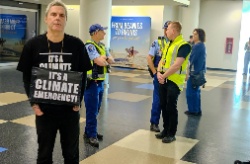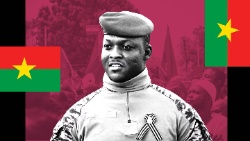Unintelligent Design
Unintelligent Design
Americans who challenge Darwinian evolution may be among the least likely to look at our history for examples with which to refute it. Surely the inability or unwillingness of generations of national leaders to ponder some of the possible lessons of the past is ample proof that while other species may be evolving the American version of homo sapiens is perhaps heading toward extinction.
A case in point is our misguided conquest of the Philippines after the Spanish-American War. Having blasted an antiquated Spanish fleet into oblivion in Manila Bay, Commodore George Deweyconfronted an enemy army still in command of the city. It took U. S. troops to defeat the Spanish force, but they did it with significant help from native rebels who had been fighting for their independence for several years. They were led by the charismatic Emilio Aguinaldo, an untutored military genius. Dewey told his civilian bosses back in Washington that the rebels had issued a declaration of independence, and that the Filipinos seemed capable of self-government. In this case an old salt who had served under Admiral Farragut in the Civil War showed that he had more brains than the striped pants set in Foggy Bottom and the occupant of the Oval Office.
Historian Eric T. L. Love’s book, “Race Over Empire: Racism and U. S. Imperialism, 1865-1900,” argues that the conventional linking of racism and imperialism is almost completely wrong. Racism proved to be not the stimulus for overseas conquests, but an almost insuperable obstacle to our foreign policy establishment and several presidents, who had designs on Santo Domingo, the Hawaiian Islands, and other possible colonies beyond the continental U. S.
Annexation of the Philippines was opposed, with varying degrees of passion, by a remarkable cast of national leaders, including Theodore Roosevelt, Henry Cabot Lodge, Alfred Thayer Mahan, Carl Schurz, Samuel Gompers, and Andrew Carnegie, for a variety of reasons, but all of them shared the racial fears that Love describes so well.
At first there seemed little desire to hold the Philippines. At best it was thought that the Navy would need a good harbor on one of the larger islands, such as Manila’s on Luzon. Oscar Strauss, a key adviser to President William McKinley, advised against entanglement in a tropical island chain halfway around the world. But because of politics, including a coming election, and because of the fear that another great power would seize the Philippines if America gave them up, McKinley decided to seize the whole chain. Both Japan and Great Britain encouraged the U.S. to do this, the former because America was viewed as less hostile than Russia, and the latter because the British feared a German annexation.
War fever, a kind of blood lust that seizes the American people every so often, was a potent force against giving up territory that we had won from the hated Spanish. Love quotes a mid-western Republican who opined that “‘As a rule, whatever arouses patriotism is good for us.’” Some members of McKinley’s cabinet also saw evangelical opportunities in the Philippines. Perhaps the president, a devout Methodist, did not know that the Filipinos had been Catholic for three hundred years. The annexation of the Philippines passed the U. S. Senate by a single vote, with a binding commitment that Filipinos would never become American citizens, nor their islands a state in the Union.
David R. Kohler (a Navy special warfare officer) and James W. Wensyel’s (a retired U.S. Army officer) essay, “America’s First Southeast Asian War” (1990), explains that the U.S. plunged into a war that would see 200,000 American soldiers sent to the Pacific, with 125,000 actually serving in the Philippines, and suffering 7,000 casualties.
About 15,000 to 20,000 Filipino rebels were killed, along with more than 200,000 civilians, all too easily dismissed as what would today be called collateral damage. There were mounting atrocities on both sides. The Americans used various forms of torture, including water boarding, to interrogate captured rebels. Though a few officers were court-martialed for sanctioning torture, their punishment was light. Our generals adopted a fortified hamlet strategy, free fire zones, and destruction of crops in the countryside to deny the rebels food.
Aguinaldo’s guerrilla tactics dragged out the war and made it one of attrition. His men received no outside help, despite pleas to Japan, because the U. S. Navy blockaded the islands. Our troops, with some exceptions, were better armed, fed, and supplied. America won the war, but paid a terrible price, the worst part of which was that neither our military nor civilian leadership seemed to have learned anything about the challenges of jungle fighting against a resolute foe supported by the local population at the end of a logistical chain ten thousand miles long. The lessons were forgotten, to be relearned in Vietnam sixty years later. #
(Michael Chesson is Founding Professor and
Dean of the new American College of History and Legal
Studies(ACHLS), in Salem, N.H. He retired from the U.S. Navy
with the rank of Captain. To request a catalog or contact
Dean Chesson email info@achls.org.)


 Bruce Mahalski: Dunedin Airport Art Protest
Bruce Mahalski: Dunedin Airport Art Protest Eugene Doyle: We Have Turned The Nagasaki 80th Into A Celebration Of Israeli Genocide
Eugene Doyle: We Have Turned The Nagasaki 80th Into A Celebration Of Israeli Genocide Ian Powell: David Seymour And The Political Left
Ian Powell: David Seymour And The Political Left Gordon Campbell: On The Costs Of Regulating Cost, And Burkina Faso As A Role Model
Gordon Campbell: On The Costs Of Regulating Cost, And Burkina Faso As A Role Model Martin LeFevre - Meditations: The Polycrisis Is Not Political And National; It’s Psychological And Spiritual
Martin LeFevre - Meditations: The Polycrisis Is Not Political And National; It’s Psychological And Spiritual  Binoy Kampmark: Ominous Plans - Making Concentration Camp Gaza
Binoy Kampmark: Ominous Plans - Making Concentration Camp Gaza